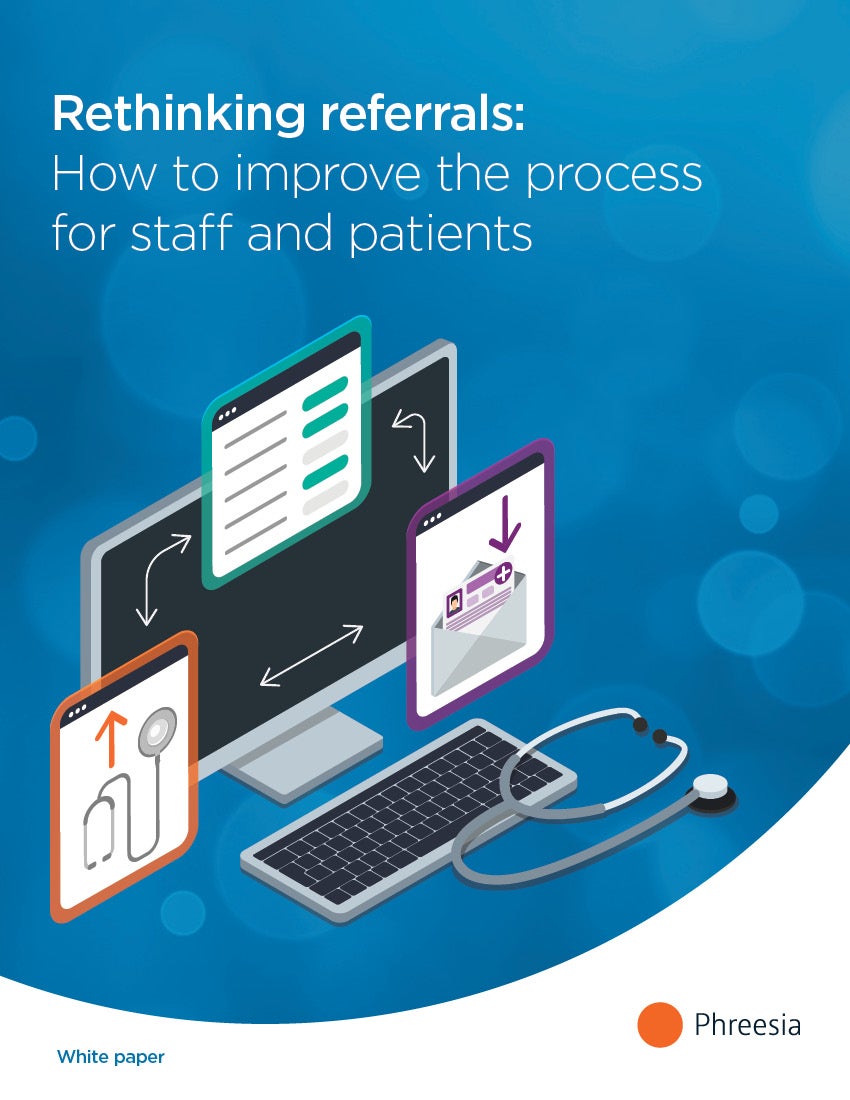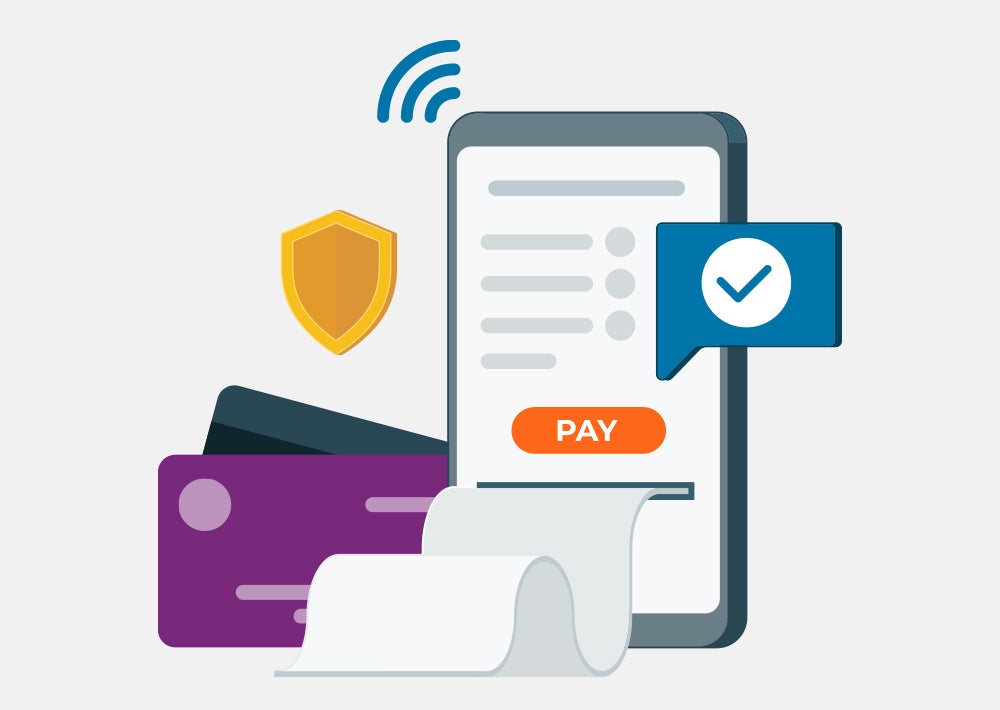Here’s a sobering statistic: Specialists receive more than 100 million referral requests every year—but only half of them get completed.
That’s a serious problem. Mismanaged referrals hurt efficiency and patient care, and they can even cost some organizations up to 10% of their revenue. Fortunately, technology is reshaping the healthcare industry, and it has the potential to transform referrals for the better.
In this white paper, we explore why the referrals process is ready for change. We also examine four ways that automation can help healthcare organizations:
- Increase referral conversion rates
- Boost referral quality
- Acquire new patients
- Minimize paper faxes
Click the image to download the white paper.

Rethinking referrals: How to improve the process for staff and patients
Executive summary
Referrals play an indispensable role in healthcare, helping millions of patients get the specialized treatment they need. Each year in the U.S. alone, 1 in 3 patients get referred to a specialist,1 and more than 100 million specialist referrals are requested in the ambulatory setting.2
But despite its critical importance, the referrals process is broken. Most physicians still rely on faxes and paper forms to manage referrals, which raises the risk of data-entry errors. Specialists often lack a reliable way to communicate with referring providers, leading to delayed diagnoses and gaps in care. Worse, most specialty groups don’t have enough staff to manage the high volume of referrals they receive. These persistent challenges cause patients to get lost in the shuffle: Of all the referrals submitted to subspecialists each year, only half are completed.2
Indeed, outdated referral workflows jeopardize efficiency, revenue and patient care. Fortunately, technology is reshaping the healthcare industry—and it has the potential to transform referrals for the better.
With the right tools and software, healthcare organizations can modernize their referrals process and deliver more effective, integrated care. They can automate and standardize manual responsibilities, reducing the risk of errors and giving physicians more visibility into every referral. And by streamlining complex tasks, healthcare organizations can minimize referral backlogs and get patients the care they need sooner—a power revenue driver, and a boon to the patient experience.
This white paper examines the most prominent challenges in the referrals process and explores how they impact efficiency and patient outcomes. It also illustrates how technology can help providers streamline referral management, combat fragmentation and deliver timely, high-quality care.
Each year, 100M+ specialist referrals are requested in ambulatory settings…but only half of those referrals get completed.
Why the referrals process is ready for change
Over the past two decades, healthcare has rapidly digitized. As of 2021, nearly all non-federal acute care hospitals use a certified EHR system, as do 78% of office-based physicians—up from 28% and 34%, respectively, just a decade prior.3 Even so, most health system executives say they’re only midway through their digital transformation journeys4—and there’s good reason to believe the referrals process is next in line for an overhaul.
As it stands today, the referrals process is riddled with issues—lost documentation, delayed communication and excessive costs, among others. Most organizations have different criteria for processing referrals, which exacerbates patient confusion and physician frustration. Mismanaged referrals also contribute to patient leakage, which is estimated to cost some organizations more than 10% of their revenue.5
- Mismanaged referrals lead to patient leakage, which can cost organizations up to 10% of their revenue or more.
But referral fragmentation hasn’t stemmed from just one cause. Rather, it’s the symptom of culminating factors that make the referrals process increasingly inconsistent and error-prone. The most common ones include:
Outdated modalities:
For a device that’s nearing its 200th birthday, the fax machine still dominates most healthcare offices. It’s still the main way that most providers send referrals,6 even as other obsolete tools get replaced with automated, high-tech alternatives.
Worse, nearly half of providers (45%) hand paper referrals to patients, and 26% verbally instruct patients to complete their referral.6 When patients have to guide themselves through the referrals process, their odds of completing the referral—and getting the specialized care they need—go down.
Insufficient tracking:
The ability to track referrals is crucial for accountability, helping clinicians ensure their patients get scheduled and seen. But up to 50% of referring physicians don’t know whether their patients have been seen by the specialist to whom they were referred.7
Without a reliable way to track referral activity, referring providers have no way of knowing whether a patient’s appointment took place. And even if it did, those providers seldom receive documentation about the visit, leaving them unaware of the patient’s diagnosis or treatment plan.
Lack of standardization:
Most specialists, both at the organization level and the provider level, differ in the information they need to complete a referral. This lack of standardization exacerbates the tens of millions of referrals each year that are never completed, most of which suffer from process errors such as missing information and faulty communication.8
When important details are missing, specialty physicians and staff must resort to time-consuming phone calls and emails to collect the information they need. But relying on manual work isn’t a sustainable solution—especially considering nearly half of physicians already feel burnt out.9
Erroneous referrals:
Not all referrals are a great fit. Perhaps an optometrist gets a referral that would be better suited for an ophthalmologist, or a referral for a patient whose insurance they do not accept.
These erroneous referrals can be challenging to reroute, resulting in care delays and poorer patient outcomes. They also hurt revenue, causing staff and physicians to waste time on referrals that provide no value to their organization.
How technology can improve the referrals process
There’s no denying the impact that referral inefficiencies impose on patients and providers. But with the right technology, healthcare organizations can close the referral loop and get patients the care they need sooner.
With an automated referral management solution, healthcare organizations can manage and standardize every referral from one place. They can monitor referrals throughout their lifecycle, which prevents patients from getting lost in the shuffle—and improves the odds of converting referrals into appointments. They also benefit from higher referral quality, which minimizes wasted time and delayed care.
Here are five ways an automated referral management platform can help your organization succeed:
1. Increase referral conversion rates
In an ideal world, every referral sent to a specialist would result in a completed appointment, or a 100% conversion rate. But inefficient referral workflows can drive that number as low as 35%, even in large health systems.11
That’s not the case for organizations using an automated referral platform, though. Research shows that automated referral platforms improve both conversion rates and scheduling speed—and even result in fewer no-shows.12 In fact, referrals managed via Phreesia are up to three times more likely to be scheduled.13
Digital referral platforms offer:
- Higher appointment conversion rates
- Faster scheduling
- Less data entry
- Enhanced tracking and reporting
- Real-time communication
- Robust analytics
It all boils down to efficiency. With a digital referrals platform, healthcare organizations can reduce administrative burden and data-entry tasks, leading to faster processing and fewer delays. They also benefit from enhanced tracking and reporting, real-time provider communication and robust analytics, all of which help staff ensure that no referral is lost or forgotten.
2. Boost referral quality
It’s not uncommon for referrals to get misrouted. In fact, a survey of Veterans Health Administration clinicians found that only 55% view their referrals as being clinically appropriate more than half the time.10
With an automated platform, healthcare organizations can minimize their risk of receiving or sending an inappropriate referral. Many third-party solutions come with customizable parameters to help providers find the right specialist for each patient, reducing the likelihood of misrouted referrals. They also give staff the ability to flag missing information, follow up with referring providers, track referred patients’ progress and more, providing an easy way to monitor every referral throughout its lifecycle.
Automating the referrals process leads to:
- Fewer care delays
- Lower healthcare costs
- Better health outcomes
Indeed, inappropriate referrals can have profound consequences, including delayed care, unnecessary costs, wasted time and poorer health outcomes. But with the right technology, healthcare organizations can avoid those pitfalls and ensure every referral is the right fit.
3. Acquire new patients
Physicians receive up to 45% of their new patients via referral, studies estimate.1 That’s great news for larger organizations that have enough resources to communicate with many other providers. But how can smaller practices get their foot in the door? how can smaller practices get their foot in the door?
- Did you know? Physicians receive up to 45% of their new patients via referral.1
The answer is simple: Implement a referral management platform that lets referring and receiving providers communicate in real time. With asynchronous software, providers can exchange notes, images and other documentation without picking up the phone. That seamlessness helps referring providers get patients the care they need—and helps specialists acquire patients looking for their unique skills and expertise.
Solid communication also helps close the referral loop, helping providers share meaningful clinical information to ensure their patients get the care they need. In fact, healthcare organizations that use Phreesia to manage referrals see up to three more new patients per provider per month.13 It’s a win for referring providers, and an even bigger win for specialists.
4. Minimize faxes and manual work
Though many EHRs have digital referral capabilities, 56% of providers still send referrals via traditional fax.6 But the fax machine is the bane of efficient referral capture, leading to documentation errors, lost paperwork and even gaps in care.
So, how can specialists and referring providers sidestep analog technology in the digital age? Implement software that works with faxes—not against them.
Healthcare organizations should look for tools that minimize manual work by automatically transcribing faxed referrals. A referral management platform achieves that goal, enabling providers to organize, prioritize and digitize every referral that comes in, all from one place. And by standardizing all referral information in a consistent format, staff will spend less time contacting referring providers to track down missing information—another efficiency driver.
- Automatically transcribing referrals helps specialists minimize manual work, avoid documentation errors and alleviate the risk of lost paperwork.
5. Schedule patients faster
Hurry up and wait. That’s the name of the game for about 36% of referral requests, which receive no acknowledgement from specialists within seven weeks of submission.14 It’s a longstanding problem that can cause patients to choose a different specialist—but technology can alleviate it.
Implementing a referral platform with built-in appointment-scheduling capabilities is key to getting patients in the door faster. Specialists’ staff can monitor every referral to ensure patients aren’t stuck waiting too long. And with the right software, specialists can even let referring providers directly schedule patients into their PM system.
- When healthcare organizations use Phreesia to manage referrals, patients get scheduled up to three times faster.
By shortening the time from referral to appointment, specialty providers can save staff time and see more patients, and the proof is in the numbers. Among healthcare organizations that use Phreesia to manage referrals, patients get scheduled up to three times faster.13
Conclusion
The referrals process is long overdue for change. Providers know what they want and need—a consistent way to manage referrals, coordinate with physicians and get patients in for care—yet the current framework is falling short. But as healthcare organizations progress through their digital roadmaps, they’re finding opportunities to streamline virtually every facet of patient care—referrals included.
Automated referral management solutions are reshaping the future of healthcare. They put providers in the driver’s seat, helping them save time and gain more control over the referrals process than ever before. By digitizing key processes and alleviating manual work, healthcare organizations can improve care coordination, acquire new patients and get them the care they need sooner—all without hiring more staff.
About Phreesia
Phreesia is the trusted leader in patient activation, giving providers, life sciences companies, payers and other organizations tools to help patients take a more active role in their care. Founded in 2005, Phreesia enabled approximately 150 million patient visits in 2023—more than 1 in 10 visits across the U.S.—scale that we believe allows us to make meaningful impact. Offering patient-driven digital solutions for intake, outreach, education and more, Phreesia enhances the patient experience, drives efficiency and improves healthcare outcomes.
To learn how Phreesia can transform your referrals process, visit phreesia.com/referrals.
End notes
1. “Referral System Turns Patients Into Commodities,” The New York Times, May 26, 2009.
2. “Are Your Patient Referrals Getting Lost in the Shuffle?” American Academy of Family Physicians, Jan. 30, 2018.
3. “2022 Report to Congress: Update on the Access, Exchange and Use of Electronic Health Information,” Office of the National Coordinator for Health Information Technology, U.S. Department of Health and Human Services, February 2023.
4. “Digital transformation in healthcare,” Deloitte, Oct. 26, 2021.
5. “Losing patients to other providers can cost some healthcare facilities up to 10 percent of their revenue,” Healthcare Finance, Nov. 9, 2018.
6. “3 patient referrals process pain points—and how to solve them,” Phreesia, Mar. 14, 2022.
7. Mehrotra A, Forrest CB, Lin CY. Dropping the baton: specialty referrals in the United States. Milbank Q. 2011 Mar;89(1):39-68. https://doi.org/10.1111/j.1468-0009.2011.00619.x
8. “Closing the Loop: A Guide to Safer Ambulatory Referrals in the EHR Era,” Institute for Healthcare Improvement/National Patient Safety Foundation, Dec. 13, 2017.
9. “Work overload triples the risk of burnout in health care,” American Medical Association, Apr. 18, 2023.
10. Vimalananda VG, Meterko M, Waring ME, et al. Tools to improve referrals from primary care to specialty care. Am J Manag Care. 2019 Aug 1;25(8):e237-e242.
11. Patel MP, Schettini P, O’Leary CP, et al. Closing the Referral Loop: an Analysis of Primary Care Referrals to Specialists in a Large Health System. J Gen Intern Med. 2018 May;33(5):715-721. https://doi.org/10.1007/s11606-018-4392-z
12. Feng A, Elias J, Hart K, Roberts P, Laskowski K. Automated Patient Navigation Platform Increases Referral Conversion for Surgical Consultations. Iproc. 2018;4(2):e11802. https://doi.org/10.2196/11802
13. Phreesia data
14. Neimanis I, Gaebel K, Dickson R, et al. Referral processes and wait times in primary care. Can Fam Physician. 2017 Aug;63(8):619-624. PMID: 28807959; PMCID: PMC5555331.




